The 1st Parachute Infantry Regiment (1er RCP).
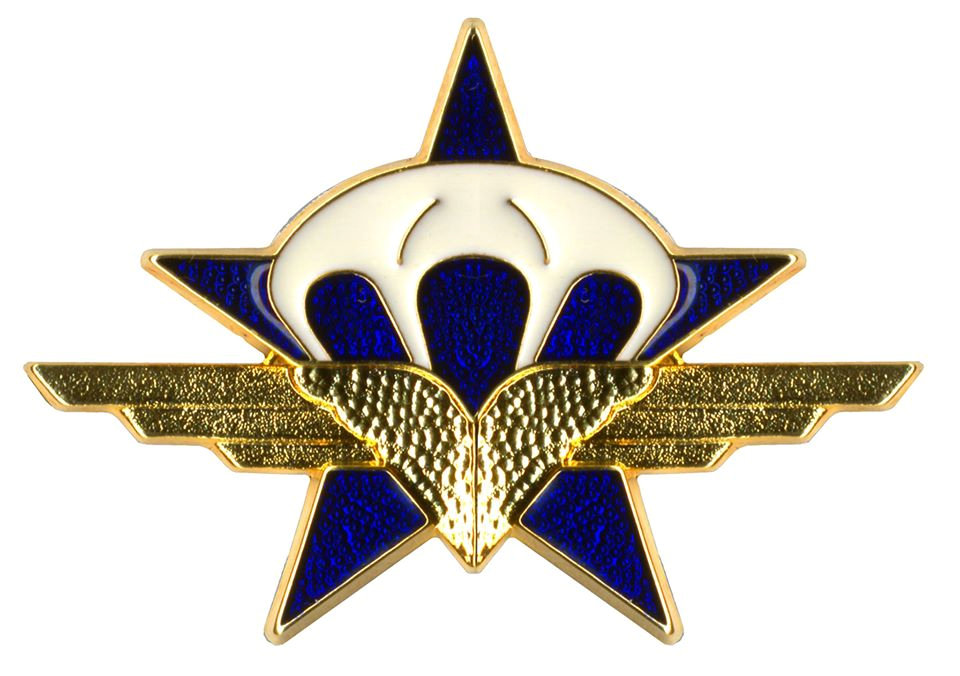
The regiment’s motto is “Victory or Death”
In January 1943, Company of the Air No. 1 was established in Fez, Morocco by Captain Sauvagnac with veterans from the 601st and 602nd Groups of the Air Infantry (601 & 602ème GIA), which had been created in July 1941.
On February 1, 1943, Company of the Air No. 1 became the 1st Parachute Infantry Battalion (1er BCP). Many young volunteers joined the unit, having traveled through occupied France and been imprisoned in Spain before arriving in North Africa.
With 700 qualified paratroopers as of May 1, 1943, the manpower allowed for the creation of a second battalion, which would give birth to the 1st Parachute Infantry Regiment (1 RCP) after the dissolution of the 1st BCP on May 3, 1943.
The 1st Parachute Infantry Regiment was officially created on June 1, 1943. colonel Geille, the “creator” of French paratroopers, took command of the regiment with major Faure as his second-in-command.
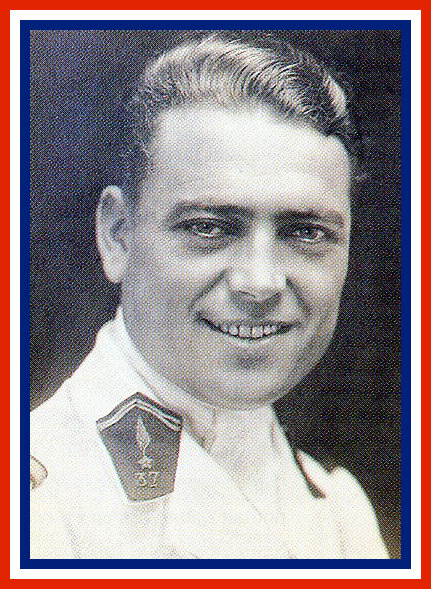
The 1st Paratrooper Regiment was an elite unit and new recruits had to undergo very demanding parachute and military training.
In October 1943, the 1st RCP left Fez and moved to Oudja to follow a training course in american airborne techniques at the Airborne Training Center (ATC) of the famous 82nd US Airborne Division.
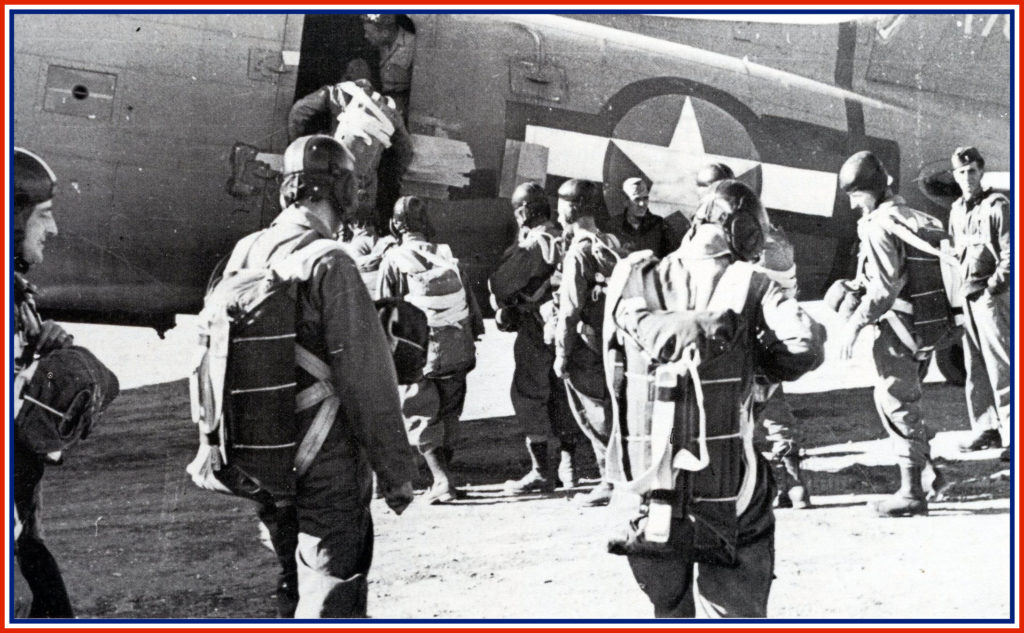
To earn the parachutist badge, one must complete 6 jumps.
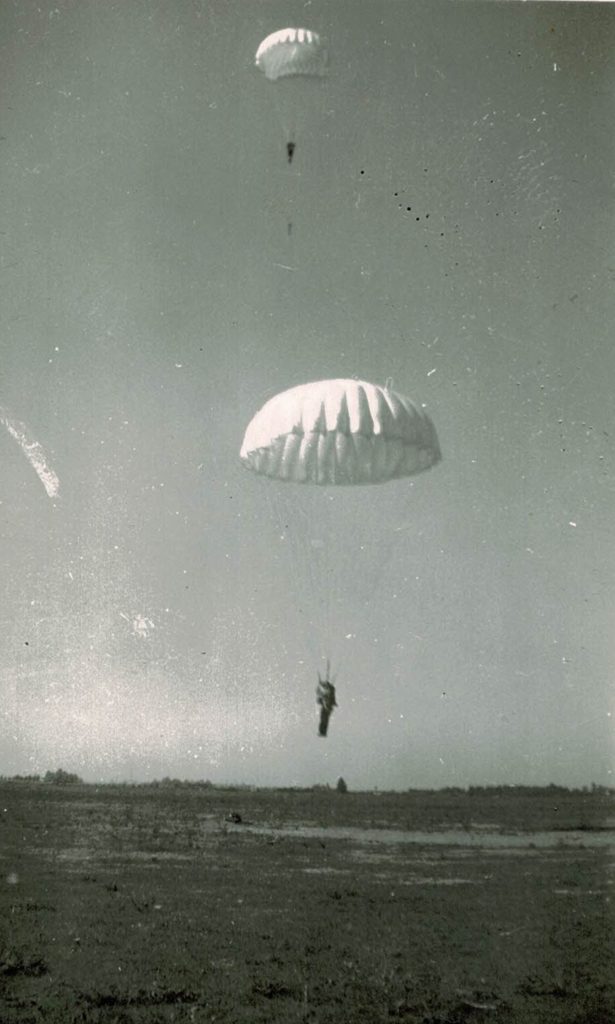
In December 1943, the 1st RCP joined Algiers after intensive training that made it one of the finest French regiments of that time, if not the best, thanks to the modern equipment provided by the US government.
From March 31 to April 7, 1944, the regiment arrived near Trapani in Sicily. For the capture of the island of Elba in June 1944, it was planned to drop the 1st RCP to prepare for the landing of 12,000 French soldiers. However, due to the reluctance of American aviators, who were concerned about the strong German anti-aircraft defenses, the airborne mission was canceled.
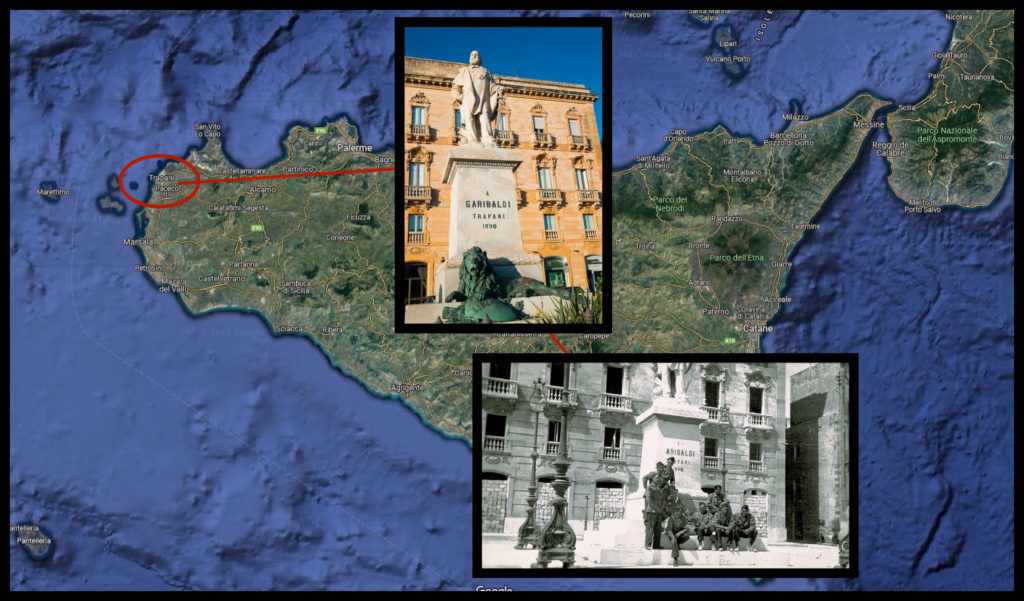
In early July 1944, the regiment joined Rome, where it was received (in its entirety) by Pope Pius XII at the Vatican during a private audience.
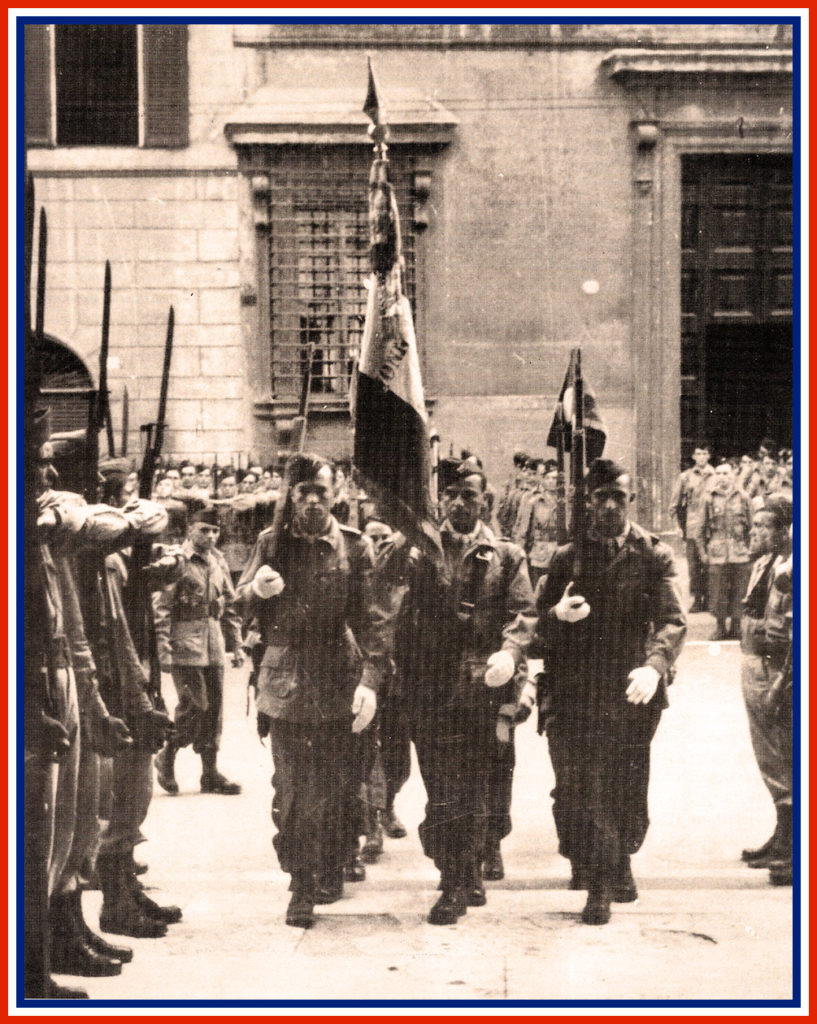
On August 15, 1944, before daybreak, about 7,000 American, British and some French paratroopers (including men from the 1st RCP) took off from Italy and participated in the Rugby Force dropped over Provence during Operation Dragoon (Provence landing).
On September 4, 1944, the 1st RCP left Rome by air to land in Valence in the Drôme region…the French paratroopers set foot on metropolitan territory again after several years of absence for many of them.
On September 15, 1944, it was regrouped facing the Belfort gap in order to be dropped on the Thann-Cernay sector (68) to facilitate a breakthrough of the 2nd Corps of the 1st French Army to liberate Alsace.
As the progress was slower than expected due to German resistance, this airborne mission was also cancelled. Impatient to participate in the liberation of the national territory, Colonel Geille asked the military authorities to fight as soon as possible…the 1st RCP was then detached to the 2nd Corps of the 1st Armored Division…the Vosges campaign has begun.
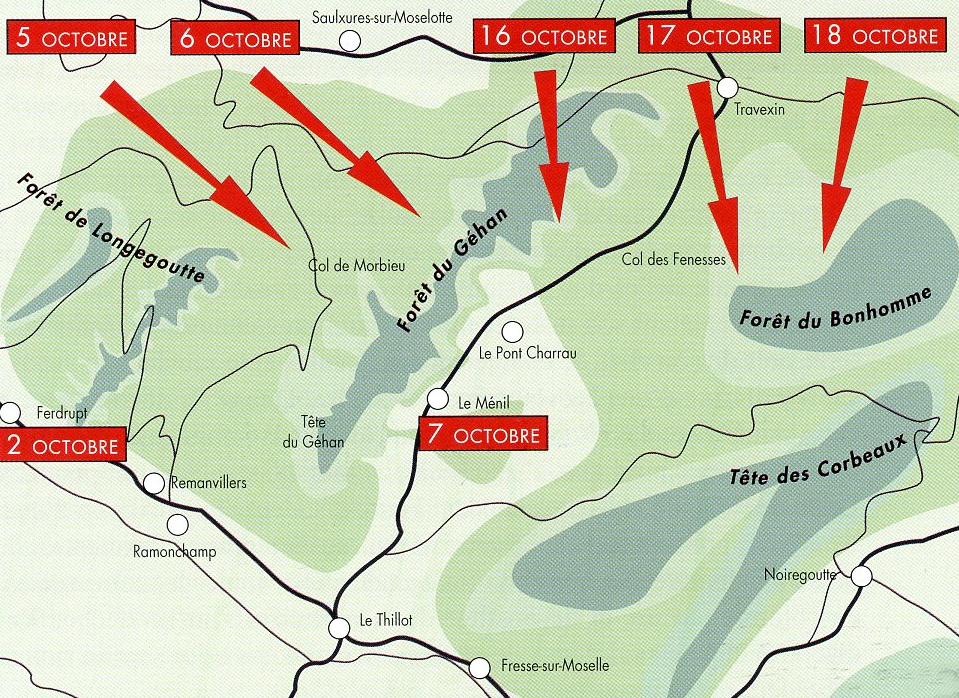
The breakthrough of the men of the 1st RCP through the German lines in the Vosges Mountains is marked by the names of the places (Ferdrupt – Col du Morbieu – Forêt du Gehan, Tête du Midi – Le Ménil – Côte 1008 – Col du Ménil – Côte 1111) where they will heroically fight under very difficult material and weather conditions, and against an enemy in superior numbers from October 2 to 22, 1944, at the cost of heavy losses: 129 killed and 339 wounded.
Faced with the losses suffered by the entire 1st Army in the Vosges, General de Lattre decides to abandon the offensive in this sector to intensify his efforts in the Belfort Gap, which will lead to the liberation of Mulhouse on November 21, 1944.
In his memoirs, General de Lattre writes in conclusion of the Battle of the Vosges: “…if the 2nd CA did not find in the Vosges the reward for its tenacity, and if it did not have the deserved joy of being the first to enter Alsace, it is nevertheless to him that Alsace owes part of its liberation. By annihilating an enemy division, by attracting to the mountains 6 battalions from the Belfort Gap, 4 taken from the front of the US 6th Corps, 7 brought from Germany and 1 repatriated from Norway, and by concentrating on him all the attention and the majority of the German means, he has durably taken over the preparation of Victory.”
On November 28, 1944, Colonel Geille left the 1st RCP to join the Air Staff, and his deputy, major Faure, took command of the Regiment.
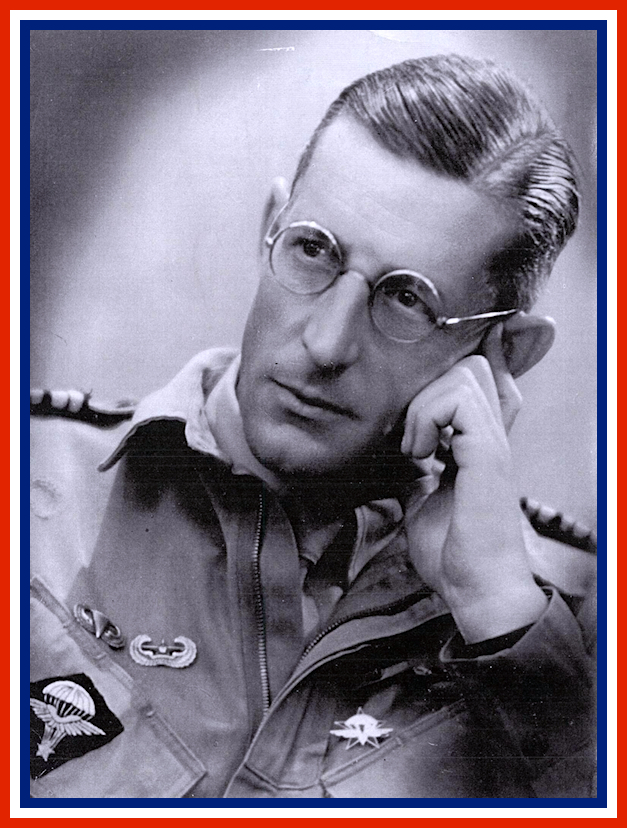
After a well-deserved rest in the region of Lons-le-Saunier and having been partially replenished by the Hémon Battalion composed with young volunteers from the Paris region (after the liberation of Paris), the regiment was sent to Alsace on December 7th, 1944.
The 1st RCP began the Alsace campaign attached to the 2nd Armored Division (2nd DB) of General Leclerc, which was to engage German troops along the Rhine by launching attacks from Gerstheim (25 km south of Strasbourg) towards Colmar to allow the 36th US Infantry Division (36th USID) to flank Colmar from the northeast.
From December 13th to 22nd, 1944, the 1st RCP fought in Witternheim (67), Neunkirch (67), Bindernheim (67), the Mayhols woods, and Friesenheim (67), under a deluge of fire and steel.
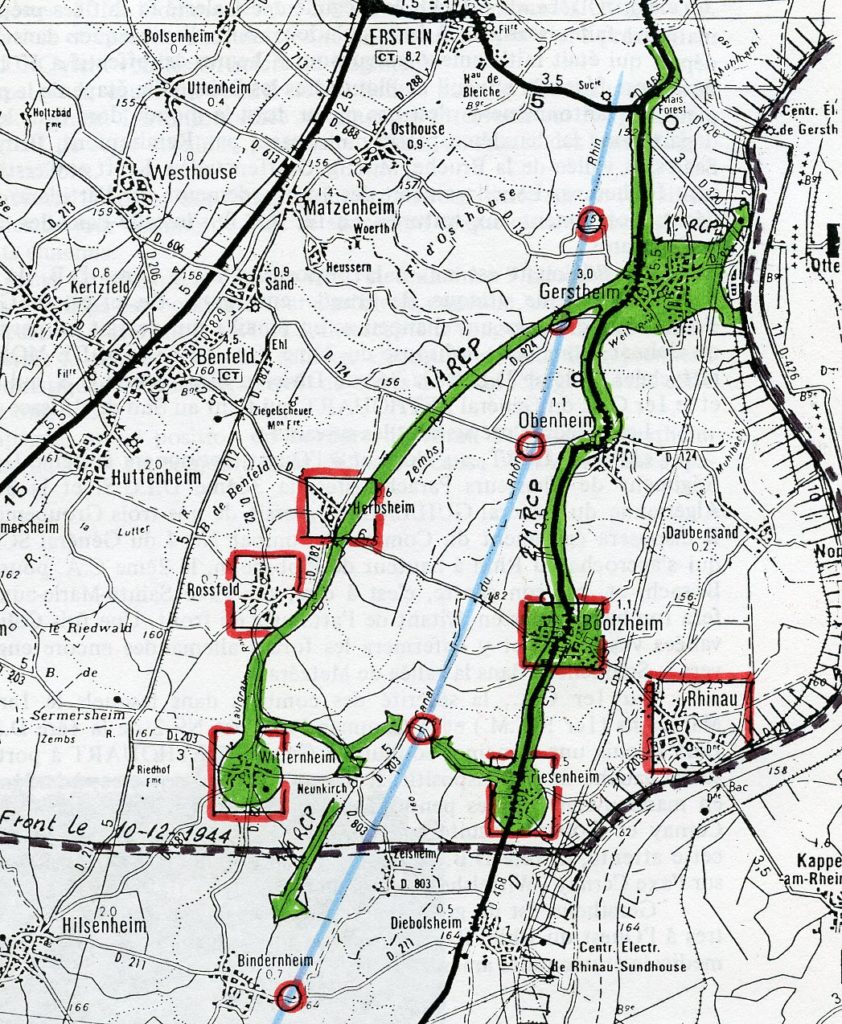
To give an idea of the intensity of the fighting, the 1st battalion of the 1st RCP lost over 200 men (killed or wounded) in just 3 days, including 10 officers and 43 non-commissioned officers.
On the evening of December 23, the 1st RCP was put to rest in Plombières for a short period, as the regiment was alerted again on December 28 and transported to Hachimette (northwest of Colmar) on December 30, crossing the Bonhomme pass with 50 cm of snow on the ground. The New Year was celebrated with cannon and machine gun fire. From January 1 to 8, 1945, the regiment was in the Orbey (68) sector, and for two weeks it occupied the Bonhomme and Schlucht passes, where ambushes and patrols were the daily routine for the paratroopers.
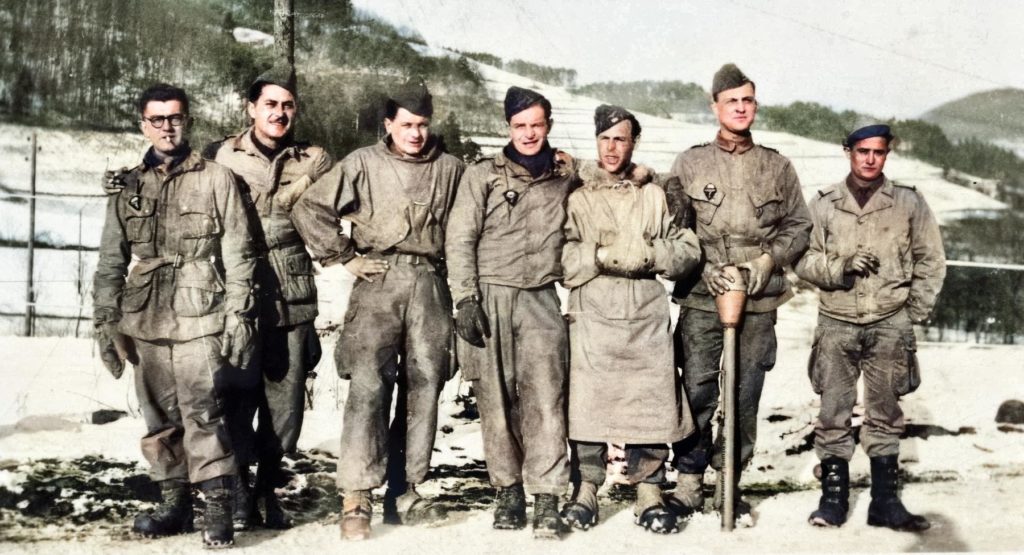
Note that some paratroopers wear the US M42 jump uniform… while others wear the mountain uniform with fur collar parka and ski pants, mountain boots and gaiters. This is the only unit to have received this mountain uniform which was highly appreciated during this period of extreme cold in the Colmar Pocket – photo 1 RCP.
Following the German counter-offensive on Strasbourg, the 2nd Battalion of the 1st RCP was dispatched urgently to Benfeld on January 9th, 1945 where it fought in Herbsheim(67) and Rossfeld(67).
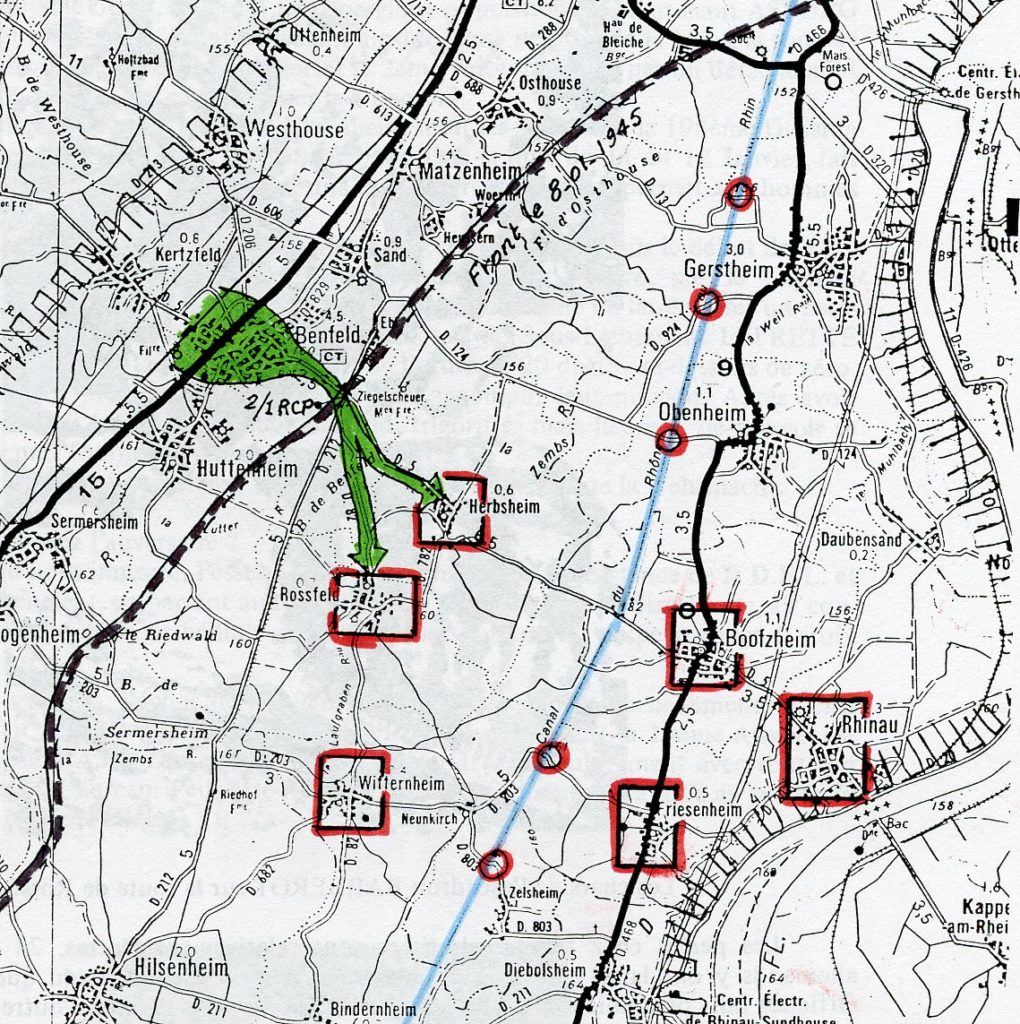
On January 15th, 1945, the 1st RCP was detached to the Combat Command 6 of the 5th Armored Division under General de Vernejoul, and would take part in the terrible battle of Jebsheim from January 25th to 30th (76 killed and 167 wounded), and of Widensolen from January 31st to February 1st, 1945 (15 killed and 45 wounded) in freezing temperatures of minus 20 degrees Celsius, facing the fearsome mountain troops of the Gebirgsjäger-Regiment 136 of the 2nd Mountain Division, an elite unit of the German army.
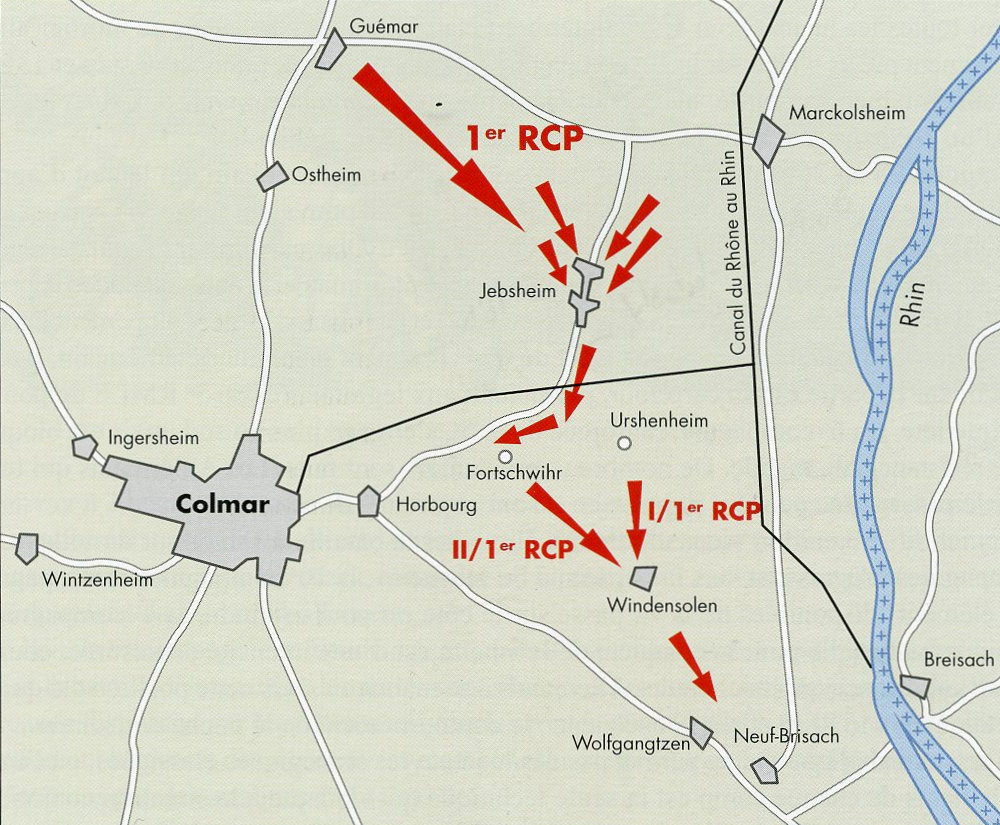
General de Lattre wrote about the battles of Jebsheim: “..nothing gives an idea of what this unfortunate village was like. 500 German corpses turned its streets into a real charnel house. We ourselves had 300 men out of action and the Americans at least as many. But we made 750 prisoners there and the 254th US Infantry Regiment more than 300. JEBSHEIM is indeed the symbol of Franco-American fraternity… it is also the symbol of the heroism spent to break through the German front line..”.
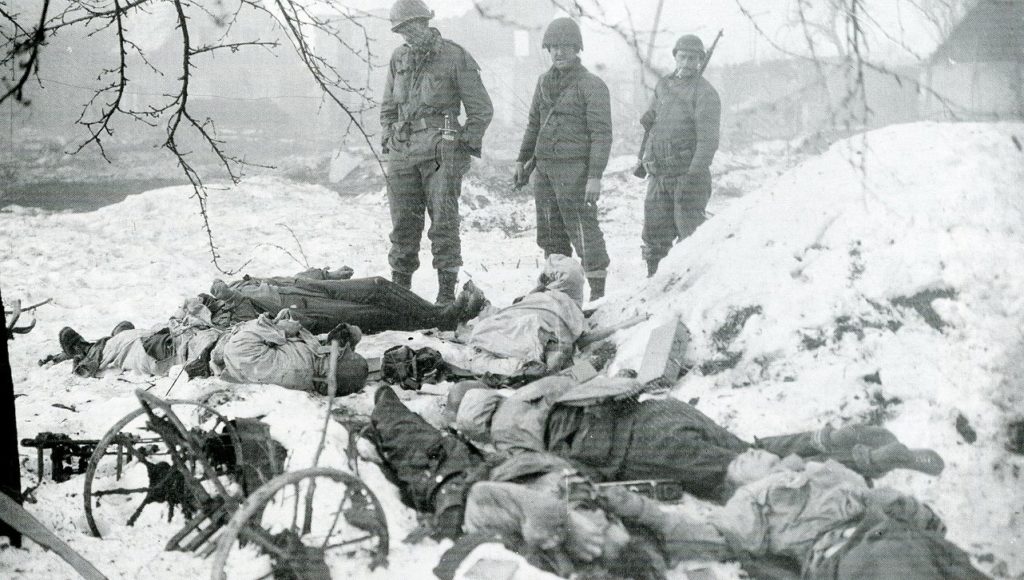
Colmar will be liberated on February 2, 1945 following these victorious battles in which the 1st RCP will have played a glorious part.
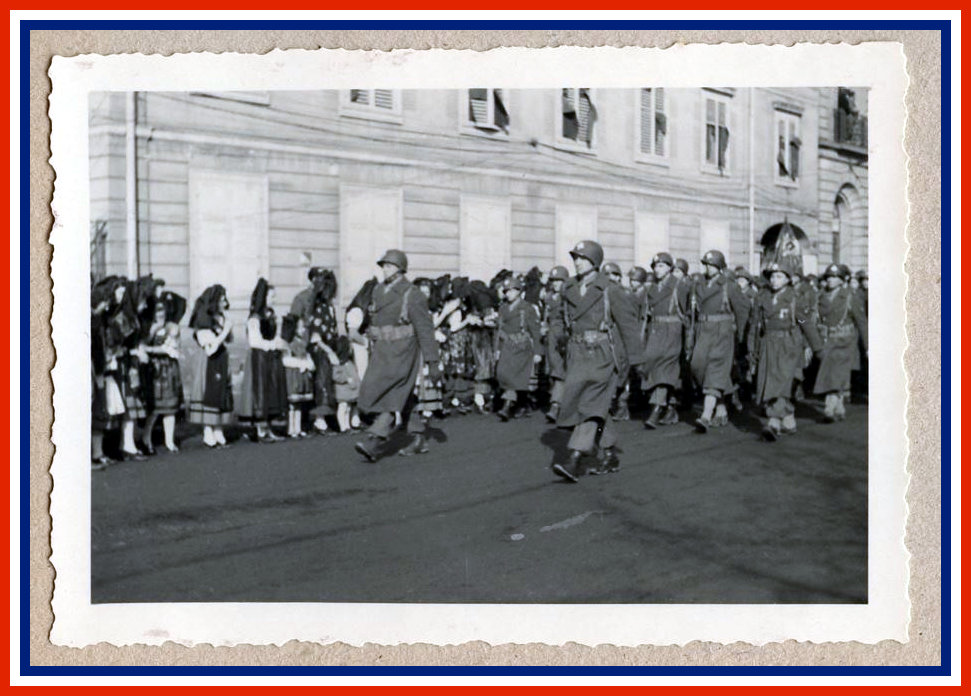
On the evening of February 11, 1945, while the majority of the paratroopers of the 1st RCP were celebrating the liberation of the Colmar pocket in the city, a German time bomb hidden in the Lacarre barracks exploded around 11 pm, killing 5 more men, injuring 15 others, and destroying almost all of the regiment’s archives.
The Alsace campaign resulted in 176 killed and 512 wounded, or 60% of its strength.
During the Vosges and Alsace campaigns, the 1st RCP paid a heavy toll, but one that was equal to the importance of the actions entrusted to it. The high command only entrusted it with difficult missions whose success could only be the expression of its worth.
We will always be grateful to the 1,156 men who were killed or wounded for their commitment and sacrifice in the service of France.
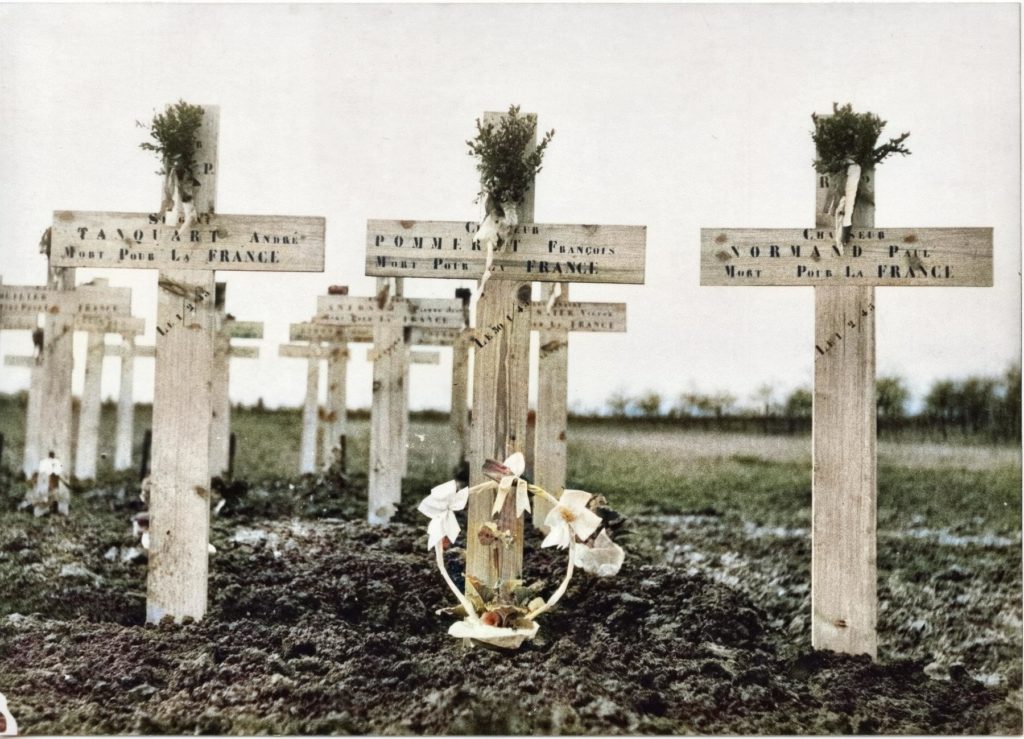
The banner of the 1st RCP carries in its folds the inscriptions of the names VOSGES 1944 and COLMAR 1945.
Its 2 citations:
For its feats of arms during the Vosges campaign, the regiment is cited:
On the proposal of the Air Ministry,
General de Gaulle, President of the Provisional Government of the French Republic, Chief of the Armed Forces, cites in the order of the Air Force
The 1st Paratrooper Regiment
“Magnificent regiment with young and ardent soul, capable of all daring and all efforts.
Under the command of Colonel Geille, remarkably assisted by major Faure, has just proved, during fifteen uninterrupted days of combat for the conquest of the Vosges passes, both its maneuvering ability and its will to win.
On October 4, 1944, infiltrating deep into the forest through the enemy’s deployment, it seizes the Morbieu pass, capturing a battery of 150 artillery, and numerous prisoners.
On the 5th, by a daring maneuver, it takes the crest of the Géhant forest, occupying it alone for twelve days, harassing the enemy and holding it in check by raids and coups de main, during which it destroys two German tanks.
From the 16th to the 18th, forcefully crossing the Ménil pass, it seizes the Rouge Gazon mountain, routing the enemy, capturing command posts and an important booty. A unit that commands admiration.”
This citation includes the award of the Croix de Guerre 1939-1945 with Palme.
For its feats of arms during the Alsace campaign, the regiment is cited:
On the proposal of the Air Ministry,
General de Gaulle, President of the Provisional Government of the French Republic, Chief
of the Armed Forces, cites in the order of the Air Force
The 1st Paratrooper Regiment
“Magnificent regiment which under the command of Lieutenant-Colonel Faure has never ceased to demonstrate, during the hard fights in which it took part, the most brilliant qualities of courage, daring and tenacity.
On December 15, 1944, it took Witternheim and Neunkirch, repulsing a hard counter-attack on the 15th.
On January 10, 1945, by an action on Herbsheim and Rossfeld, it allowed the relief of the encircled units, taking many prisoners including several officers.
Then, in close liaison with the tanks of the 5th DB, it participated on January 28 and 29, 1945 in the capture of Jebsheim where, after two days of incessant fighting going up to hand-to-hand combat, it succeeded in seizing the village whose possession was crucial for the rest of the operations, and on February 1, 1945, it took Widensolen in one leap, then enlarging the conquered zone by a succession of successful operations.
An elite unit with high morale, which always knows how to impose its will on the enemy in all circumstances.”
This citation includes the award of the Croix de Guerre 1939-1945 with a Palm.
